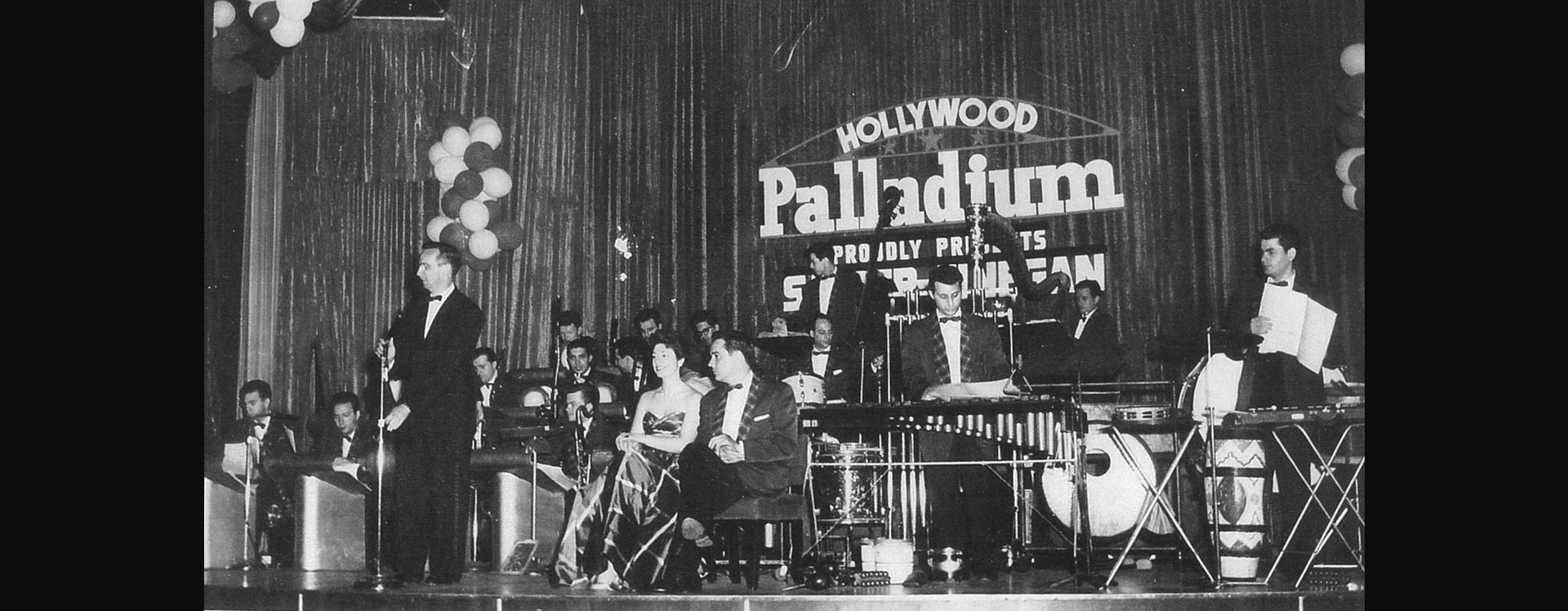

Photo above: The Sauter-Finegan Orchestra circa 1954. Below: Sauter on the bandstand at Café Rouge, Hotel Statler (formerly Hotel Pennsylvania), New York City, Thanksgiving 1954.
The initial concept for Sauter-Finegan was to create a library completely consisting of original compositions. Dave Kapp at RCA disagreed and suggested that they include arrangements of tunes that would be familiar to the audience.
This was a concession that Bill Finegan retroactively regretted, though he did acknowledge that a few fine arrangements of standards did emerge, including the chilling rendition of "April In Paris".
With two master arrangers at the helm, there were several ways the pieces for the band could have been crafted. Early on in their partnership, Sauter and Finegan took to writing the arrangements together. According to the program from a 1953 Sauter-Finegan tour:
"Sometimes Bill will take one portion and Eddie another; then the two parts are integrated into the whole. At other times, they work side by side throughout the entire arrangement, sketching ideas together, then one of them talking over and filling in the details of the orchestration."
While the first sides were arranged in this fashion, over time, Sauter and Finegan would begin to do their arranging on their own time. The two would discuss their current respective projects, but their vastly different work habits made it quite difficult for all their efforts to be combined. Eddie would often need to work on things over a period of time rather than pulling all-nighters owing to his medical condition and the bouts of fatigue he encountered.
Finegan, on the other hand, appears to have been a last-minute writer, as one composition "New York–4 AM" that he allegedly wrote just before a recording date would indicate. Woodwind player Wally Kane, who was the youngest member of the band and remained there for almost its entirety, believed that there were instances in which Sauter would sometimes help Finegan to finish arrangements that he was hung up on.
It was a common practice during this period for arrangers to assist one another with finishing arrangements, especially when the demand for charts was so high in such a variety of mediums (record dates, radio, television, live gigs, etc.).

Recommended: Listen on headphones or external speakers.
Sauter-Finegan Orchestra
"Stop! Sit Down! Relax! Think!" – May, 1952
"Azure Te (Paris Blues)" – May, 1952
MAY 1952 BAND: Joe Ferrante, Bobby Nichols, Nick Travis (trumpets); Bill Harris, Vern Friley (trombones); Bart Varsalona (bass trombone); Bill Barber (tuba); Sid Cooper, Al Klink (alto sax, clarinet, flute); Babe Fresk (tenor sax, clarinet); Boomie Richman (tenor sax, bass clarinet); Sol Schlinger (baritone sax, reeds); Ralph Burns (piano); Verley Mills (harp); Barry Galbraith (guitar); Trigger Alpert (bass); Don Lamond (drums); Walter Rosenberger, Jim Timmens (percussion); Eddie Sauter, Bill Finegan (arrangers, directors).
"Rain" – July, 1952
"Nina Never Knew" – November 1952
NOVEMBER 1952 BAND: Bobby Nichols, Joe Ferrante, Nick Travis (trumpet); Vern Friley, Bill Harris (trombone); Bart Varsalona (bass trombone); Bill Barber (tuba); Al Klink, Sid Cooper (alto sax, flute); Joe Palmer, Charlie Albertine (tenor sax); Sol Schlinger (baritone sax); Lou Stein (piano); Mundell Lowe (guitar); Trigger Alpert (bass); Don Lamond (drums); Dick Ridgley, Phil Kraus (percussion); Verley Mills (harp); Joe Mooney (vocal) with Ray Charles Singers: Gene Lowell, Artie Malvin, Steve Steck (vocals), The Doodlers : Sally Sweetland, Lillian Clark (vocals); Eddie Sauter (arranger,director,toy-trumpet); Bill Finegan (arranger,director).
"We wanted a different combination of instruments. We came up with one that gave us plenty of latitude - from piccolos to a tuba." — Eddie Sauter to New York Times 1977